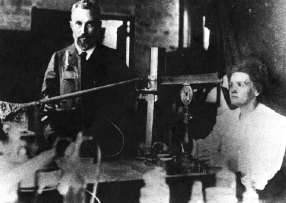![]()
![]()
When Antoine Henri Becquerel (1852-1908) discovered on March 1, 1896, that pitchblende emits radiation even without being energized by the sunlight necessary to cause luminescence (see details), he suspected that the element Uranium was responsible. While pitchblende is a complex substance known to contain many elements, Becquerel had chosen to work with pitchblende because many Uranium compounds were known to fluoresce. When he investigated several diverse Uranium compounds and found all were radioactive he concluded that the Uranium was responsible for the phenomenon. Later Becquerel found that the radiation ionizes gases.
 Fellow Parisian physicist, Pierre Curie, (1859-1906 shown at right) having earlier discovered the piezoelectric effect, developed a sensitive electrometer and a piezoelectric quartz useful for rapidly measuring the intensity of radiation. The ionized air caused by the radiation causes electric charge to leak away at a rate proportional to the radiation intensity. When Curie's wife Marie measured a large number of metals, salts, oxides, and minerals she found their radioactivity was generally proportional to their content of Uranium and Thorium. She noted these were the two most active elements and also the ones which possess the greatest atomic weight.
Fellow Parisian physicist, Pierre Curie, (1859-1906 shown at right) having earlier discovered the piezoelectric effect, developed a sensitive electrometer and a piezoelectric quartz useful for rapidly measuring the intensity of radiation. The ionized air caused by the radiation causes electric charge to leak away at a rate proportional to the radiation intensity. When Curie's wife Marie measured a large number of metals, salts, oxides, and minerals she found their radioactivity was generally proportional to their content of Uranium and Thorium. She noted these were the two most active elements and also the ones which possess the greatest atomic weight.
However two of the Uranium mineral samples did not fit the pattern. Marie Curie (1867-1934 also at right) wrote, Two minerals of Uranium, pitchblende (a uranium oxide) and chalcolite (uranyl copper phosphate) are much more active than uranium itself. This fact is most remarkable, and suggests that these minerals may contain an element much more active than uranium. I prepared chalcolite from pure reagents according to the procedure of Debray; this artificial chalcolite is no more active than other uranium salts.
(read her original translated by Carmen Guinta) To chemically analyze natural pitchblende to isolate any other radioactive element needed a chemist. Marie Curie had struggled as a girl in Russia occupied Poland to secretly obtain an education that was banned for women by the Czar. As part of Warsaw's underground
Polish university, she had obtained laboratory space and practiced experiments from chemistry and physics textbooks. To advance further she moved to Paris where women were at least tolerated as students at the Sorbonne. (But even Parisians, like other Europeans, generally believed that women should remain at home leaving paid jobs for men.) There she earned degrees in physics and mathematics and in seeking laboratory space, had met Pierre. Abandoning her plan to return to Poland to teach school, she undertook with assistance of a chemist friend, André Debierne, to analyze pitchblende and isolate the source of the radiation. (read more.)
Marie dissolved the pitchblende by heating in acid, then precipitating several metals including the source of radiation by adding hydrogen sulfide, leaving Uranium and Thorium in solution. When ammonium sulfide was added to the precipitate several metals dissolved and were also removed. The remaining radioactive solid was next dissolved in nitric acid. Addition of dilute sulfuric acid left the radioactive material dissolved but removed Lead. Finally ammonia precipitated from the mixture the radioactive material accompanied by only Bismuth. Later Marie found a second radioactive material was soluble when treated by hydrogen sulfide, having similar properties to Barium. Since neither of these radioactive substances were identical to accompanying Bismuth or Barium, Marie had isolated two new metallic elements which were radioactive. The first she named Polonium after her native country, Poland, then nonexistent having been absorbed by Russia! The second was named Radium because of its intense radioactivity. (The Classic Chemistry Papers by Carmen Guinta contains her papers announcing Polonium and Radium.)
In Experiment VI we repeated Becquerel's experiment, leaving a radioactive source on covered photographic film, finding that the radiation caused an image on the film. We can now take our analysis further, using a process of elimination similar to the logical process that chemists use to for chemical analysis. But instead of using chemical techniques known to separate different groups of substances that can be tested for radioactivity, we will use our previous tests for radioactivity and the known chemical composition of the different substances in the boxes.
| Box | Contents | Formula | Box | Contents | Formula | |
|---|---|---|---|---|---|---|
| A | uranium sulfate | USO4 | D | sodium nitrate | NaNO3 | |
| B | sodium sulfate | Na2SO4 | E | thorium nitrate | Th(NO3)2 | |
| C | uranium nitrate | U(NO3)2 | F | sulfur | S |